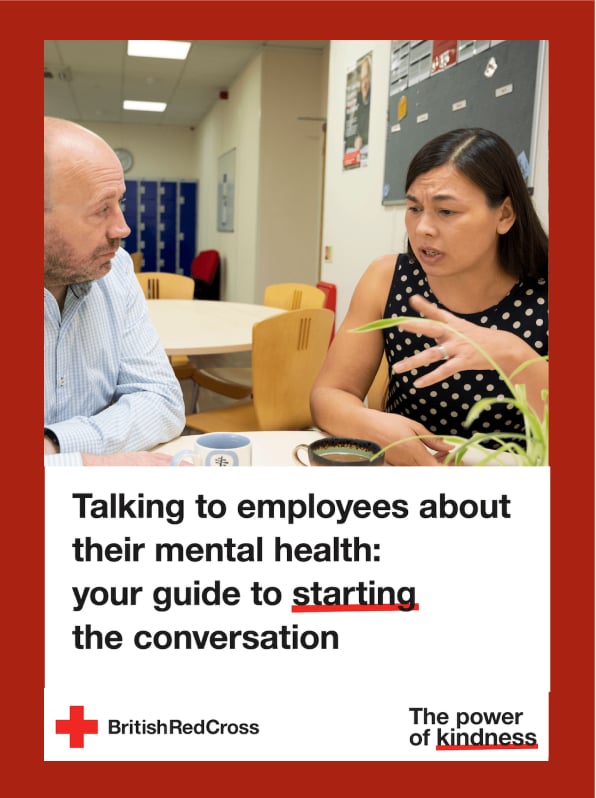How important is the language we use when talking about the difference between mental health and wellbeing in the workplace? Louise Fernand, Product Manager for Mental Health and Wellbeing at Red Cross Training, explains the meaning of these two terms and how understanding them can help you support your team.
In recent years there has been a significant increase in discussion about how to improve mental health in the workplace, as employers have become more and more aware of the importance of supporting their employees’ wellbeing and responding to their needs.
When it comes to having conversations about mental health and wellbeing, however, it can be confusing to know which term to use. Mental health and mental wellbeing, while independent terms, are closely connected.
What is mental wellbeing?
Mental wellbeing means different things to different people. It’s often used to refer to how we feel about our lives, or how well we feel we are able to navigate the things we experience on a daily basis – life's ups and downs.
When we talk about having positive mental wellbeing, we might be referring to how fulfilled we feel; how comfortable we feel in ourselves, and how well we are enjoying the experiences in our lives. Positive mental wellbeing can also relate to feeling a sense of purpose, or feeling able to find connections with others.
Employee wellbeing is defined as the overall mental, physical, emotional, and economic health of your team. It can be affected by many factors such as relationships at work, decisions made, and tools and resources. Employee engagement and wellbeing will vary between people, but it should average out to create a productive and healthy work environment.
Boost positive mental wellbeing in your workplace
Our online course, Wellbeing Support at Work, equips you and your team to provide effective support while prioritising personal wellbeing.
What is mental health?
Everyone has mental health, just as everyone has physical health. It can be helpful to consider mental health as a spectrum as opposed to extremes: a line that extends from no distress to high distress.
Mental health is defined as ‘a state of wellbeing in which every individual realises his or her own potential, can cope with the normal stresses of life, can work productively and fruitfully, and is able to make a contribution to her or his community.’ (World Health Organisation 2014).
Our mental health has an impact on:
- How we handle stressful situations.
- How we make decisions.
- How able we feel to live our daily lives.
- How we interact with those around us.
How does mental health and mental wellbeing relate to the workplace?
There are many different factors that can commonly have a negative impact on people’s mental wellbeing in the workplace; and in turn, poor mental wellbeing can have an impact on mental health. From workload to deadlines to poor colleague relationships, working life is full of things that can influence how we feel.
Supporting employees in their mental health and wellbeing and fostering an open and positive environment can make a powerful difference to an organisation. When they feel supported, staff can be more engaged, motivated and productive and will have greater confidence in dealing with stressful situations.
Ensuring your organisation develops a considered mental health and wellbeing policy can have a positive impact: our blog Creating a mental health plan for a healthy and productive workplace can help.
Equip your team for a healthier, happier workplace
Our Wellbeing Support at Work course is your guide to fostering a supportive, open environment that enhances productivity and engagement.
What can be done to support our mental wellbeing and mental health?
Employers should look at how to improve employee wellbeing and take steps to help foster a productive and healthy work environment in the form of an employee wellbeing strategy. There are lots of ways we can try to improve our mental wellbeing, such as spending time outdoors, finding ways to reduce stress, keeping active and connecting with other people. There are also many ways to support employees’ wellbeing in the workplace; whether it’s allowing more flexibility over how and where they work, showing appreciation and recognition, or fostering an environment in which employees are enabled to connect with each other.
Mental wellbeing training is also available for both employers and employees; for example, Red Cross Training’s online Wellbeing Support at Work course is designed to equip you, and your team, with the skills and knowledge needed to provide effective support to others, while also taking care of your own wellbeing. The skills covered will help learners build personal resilience and bounce back when faced with situations that are stressful, upsetting or challenging.

One in four of us will experience mental health problems in the workplace at some time in our lives. And yet, there is a stigma attached to mental health problems which may result in people hiding their difficulties and being reluctant to tell family, friends or work colleagues, or to seek treatment or support.
One way to help challenge mental health stigma at work is to talk about our own difficulties, as difficult as this may be. This can help to normalise the conversation and encourage others to share when they are finding things difficult. We can also help by being non-judgmental, empathetic and avoiding language that stigmatises or is disrespectful of those experiencing mental health problems.
Mental health vs mental wellbeing: why does it matter?
With these two terms relating so closely to each other, it can be confusing to know which one you should be using when. But the important thing is to be led by the individual you are supporting and to respect their own choices and language when they discuss their experiences.
One of the most effective ways to support your employees when they’re going through a difficult time is by practising active listening. This means listening to their story from their perspective, and letting them explain what they are experiencing and how it is affecting their work. You should listen closely and quietly, and use their own words and language to try and summarise what you’re hearing.
So, if the individual prefers to talk about their mental wellbeing rather than their mental health, or vice versa, following suit will help them feel they are being heard and understood. Using your employees’ language – whether they’re talking about mental health or mental wellbeing - can help to build a feeling of closeness and generate trust.
Topics: Mental Health at Work, Mental Wellbeing, Mental Health






